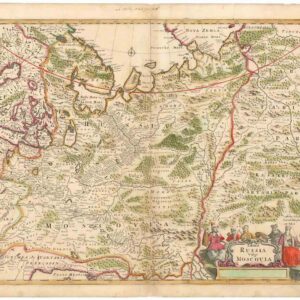An early map of Stalin’s horrific Gulag system by one of the most ardent critics of Communism in the United States.
Carte de l’Esclavage en U.R.S.S.
$875
In stock
Description
The Carte de l’Esclavage en U.R.S.S. is a French edition of a crucial piece of anti-Communist literature showcasing the Soviet Gulag system. The map’s expansive reach stretches from Berlin to the Bering Strait and the Pacific Ocean, situating the Soviet Union across Europe and Asia. Red dots and symbols denote the extensive camps, supplemented by descriptive French text detailing the horrors of the Gulag and its role in Soviet governance.
The map served as a compelling visual tool for depicting the widespread reach of the Soviet Gulag system. Displaying a thematic distribution of these camps across the Soviet Union, the map exaggerated the country’s extent, thereby implying the vastness of the Gulag infrastructure. Marked by red dots and symbols indicating local or centralized control, the camps spanned the nation. The map is accompanied by descriptive columns outlining the brutality of Gulag life and the significant role the threat of Gulag imprisonment played in the Soviet regime.
The map’s origins can be traced to a Polish-language expose, Sprawiedliwość Sowiecka, published by Sylvester Mora and Pierre Zwierniak in Rome in 1945. The purpose of the publication was to describe the Soviet Gulag system using prisoner testimonies. Isaac Don Levine, editor of the anti-Communist magazine Plain Talk, introduced an English version of the map to his magazine in 1947. The map’s wide circulation prompted the American Federation of Labor (AFL) to advocate for a UNESCO investigation into forced labor, culminating in an updated version in 1951, forming the basis of our example.
The map became a tool for psychological warfare during the Cold War era, underscoring the need for NATO (founded in 1949) to contain the aggressive Soviet Union.
Context is Everything
During the Cold War, the Soviet Union’s Gulag system, a network of forced labor camps established post-Russian Revolution, housed millions of prisoners, including political dissidents, criminals, and prisoners of war. Following World War II, the severity of the Gulag system became a focus of anti-Communist propaganda efforts, offering ammunition to Cold Warriors both in America and globally.
Census
Produced in 1951, this edition was based on the original by Isaac Don Levine but edited by the Centre d’Archives et de Documentation in Paris. Only a few institutional copies exist (OCLC nos. 494888470 & 255289731), making this a rare and significant find for Cold War collections.
Cartographer(s):
Isaac Don Levine (1892-1981) was a Russian-born journalist, writer, and visualizer (i.e., mapmaker) who immigrated to the United States in 1911. He began his journalism career with The Kansas City Star. He later worked for The New York Herald Tribune, covering significant events like the Russian Revolution and the ensuing Civil War in Russia. Later in life he collaborated with defector Walter Krivitsky on articles detailing Stalinist Russia, contributing to anti-Communist discourse. Levine also served as the editor of Plain Talk, fostering anti-Communist sentiments, and played a role in the Alger Hiss case. His involvement in the creation of the Gulag map aligned with his anti-Communist stance, utilizing maps as tools for psychological warfare during the Cold War.
Condition Description
Wear along folds and pin holes in corners.
References
![[Map of Steamship Routes and the Railways and Post Roads of the Russian Empire]](https://neatlinemaps.com/wp-content/uploads/2020/04/NL-00827_Thumbnail-300x300.jpg)
![[Map of Steamship Routes and the Railways and Post Roads of the Russian Empire]](https://neatlinemaps.com/wp-content/uploads/2020/04/NL-00827-scaled-300x300.jpg)

![Novorossiysk, with insets of Tuapse and Batumi [Порт Новороссийск]](https://neatlinemaps.com/wp-content/uploads/2022/07/NL-01453_thumbnail-scaled-300x300.jpg)
